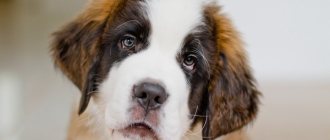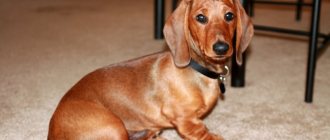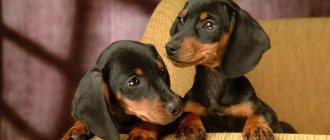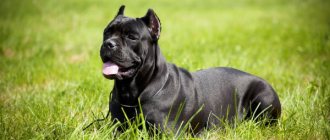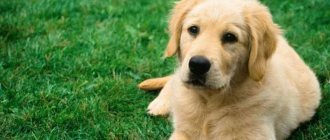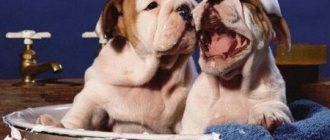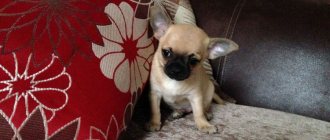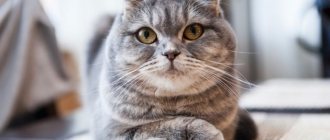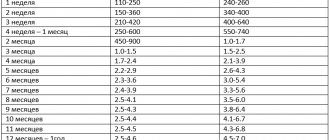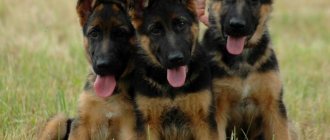Origin story
The ancestors of the modern mastiff lived for centuries in the Pyrenees, Extremadura, Andalusia, on the Catalan coast and other historical regions of Spain. The economy in this area was based on sheep farming, which flourished largely thanks to mastiff dogs (that’s what the Spaniards called the guards of the herd, without any prefixes or additional words). Mastiffs were born and lived together with sheep and were an integral part of the herd, so when the owner of the flock changed, the dog was given away along with the cattle. Different territories developed their own type of dog, which was suitable for specific local conditions and climate.
The breed developed thanks to sheep farming. In his chronicle of shepherd life, Emanuel Delrio noted that there were usually five mastiffs per thousand sheep. If we compare these data with the number of livestock in the 18th century, we get a figure of about 20,000 individuals. Cattle breeders strictly selected dogs for working qualities, but also took into account external characteristics, such as the depth of the body, head size, the presence of folds and jowls.
Despite their large numbers and widespread distribution, mastiffs did not receive much attention until the 20th century.
The first officially registered mastiff was a piebald male named Machako. In 1906 he was recorded in the Spanish stud book. He could not be called a standard of beauty, but no other mastiffs were brought to the exhibition in Madrid. Under the pressure of urbanization, wolves began to leave the vicinity of villages, and with them small fur-bearing animals, which were the main food for large dogs. Farmers began to switch to more comfortable dogs, small and agile. The breed began to degenerate and was preserved only thanks to individual sheep breeders who continued to breed mastiffs, and, of course, to breeders who remembered their national heritage and laid the foundation for factory breeding of the Spanish Mastiff.
The first description of the Spanish Mastiff was written in 1946 for the FCI by breeder Luis Del Portillo, in which the dogs were described as large dogs with short hair. In the late 50s, Luis began searching for large mastiffs, which he collected from pastures in the province of Leon. In the early 60s, a significant contribution to the breed was made by the breeder Amodel Alejandro, who from the 70s to the 80s was involved in breeding and popularizing large dogs. It was his dogs that laid the foundation for several lines that are still known to this day: Manalo Martineda, Ermiño Tascona, Sacaries Pieto and El Pinotara.
At the end of the 70s, a new standard was created that was more consistent with the modern appearance of Spanish mastiffs. In 1981, the breed was officially recognized by the Fédération Cynologique Internationale and a Spanish Mastiff breeding program was developed under the leadership of Carlos Solas. The first Spanish mastiff appeared in Russia in 1995, and in 1996, 10 more dogs were imported from the Czech Republic and Spain, which became the founders of Russian lines.
The number of nurseries began to increase, of which today there are already more than 10.
Video about the Spanish Mastiff dog breed:
History of the breed
The history of the origin of the Spanish mastiff begins in the Spanish province of Extremadura, bordering Portugal. The breed was not specifically bred until the beginning of the 20th century. But in 1906, a puppy named Machako was born. Systematic breeding began with him. The puppy was entered into the Spanish stud book.
The breed was first described only in 1929 under the name “mountain Spanish mastiff”. The owner of the Trasumancia nursery, Luis Escurio, set out to find the largest representatives of the breed and, as far as possible, make improvements to it. To do this, he explored the mountainous areas of northwestern Spain.
As a result of the search, the dog Navarro was discovered, which turned out to be the largest representative of the breed, and in 1959 he was exhibited at the Madrid Agricultural Exhibition.
In the 60s of the last century, another kennel specializing in mastiffs appeared, called “El Pinotar”, owned by Amadeo Alejandre. By the 1980s, the dogs from this kennel were very popular.
It was these two breeders who were able to lay the foundation of the breed over 40 years, although they had different views on the standards of Spanish mastiffs.
Appearance
The Spanish Mastiff is a large dog, well-built, muscular, powerful, with a large head and medium-length hair. The body has an elongated shape, but harmony and lightness should be traced in movements and proportions. gender identity is guessed very well. The height at the withers for males is from 77 cm, for females - from 72 cm. Weight is not defined by the standard, with a minimum size of 70-80 kg.
The head is strong, large, shaped like a truncated pyramid with a wide base. The skull is strong, with a pronounced occipital protuberance and a convex profile. The large upper lip covers the lower lip, and the jowls are well developed. The teeth are strong and white. The eyes are small in relation to the skull, almond-shaped, preferably dark in color. The eyelids are pigmented and thick. A slightly drooping lower eyelid allows you to see the mucous membrane. The ears are drooping, triangular in shape, flat, medium in size, and can be cropped. The sky is black.
The neck is strong, flexible, with a well-developed dewlap. The body is rectangular in shape, powerful and strong, indicating great strength, but at the same time mobile. The back is flexible and powerful. The ribs are rounded. The loin is wide and long. The croup is strong, its height is equal to the height at the withers. The chest is deep, wide, very powerful. The tail is thick, reaching to the hocks, and the terminal quarter is often curved. The front legs are straight, parallel, strong, with powerful pasterns. The hindquarters are straight when viewed from behind, with long and strong bones. The feet are round and the toes are close together. Single or double dewclaws are desirable on the front and hind legs, but their absence is acceptable.
The skin is thick, elastic, forms many folds, and has good dewlap in the neck and abdomen. The coat is long, thick, with a well-developed undercoat, shorter on the legs, longer on the tail. The color can be different, the most valuable uniform ones are red of any shade, black, as well as any variants of these colors - motley and brindle.
Appearance
The description of the Spanish Mastiff breed says that it is a harmonious, huge dog with powerful bones and a deep chest. The height of males is up to 80 cm, females are up to 75 cm. A characteristic feature of the breed is loosely hanging skin with a substantial dewlap in the neck area.
The coat is thick and dense, slightly rough in texture. The breed standard for the Spanish Mastiff provides for any color. These gigantic dogs are red, gray, black, fawn, brindle, and they also have white spots on their chests and paws.
The Spanish Mastiff is a guard from birth, very strong and efficient. Functionally, it can be anyone, depending on the desire of the owner. Mastiffs are distinguished by exemplary behavior. When they are in the family, they are affectionate and non-aggressive dogs.
Mastiff puppies - small, plump bear cubs - waddle funny on their big thick paws. However, the serious look of the kids and the ability to carry themselves with dignity from an early age mark them out as future formidable guards.
Character
The appearance well reflects the purpose and character of the Spanish Mastiff. This is an amazingly hardy and efficient dog that can perform a wide variety of functions, depending on what the owner requires of him. But, first of all, they are intended to accompany the flock, as well as to protect people and their property. When surrounded by family, the Spanish Mastiff behaves calmly, he is affectionate and gentle. This is a reliable friend and faithful assistant, very sociable and sensitive. Despite his menacing and slightly aloof appearance, he is in great need of attention and love. Mastiffs are more family-oriented and sociable than many other guard breeds.
Spaniards are mentally balanced and not prone to unmotivated aggression. Outwardly they seem to be indifferent melancholics, but their appearance changes dramatically when a real threat appears on the horizon. The big soft bumpkin turns into a large, physically developed, powerful, vicious dog, confident in itself and in its abilities, capable of a swift attack.
The Spanish Mastiff will become a faithful friend to the child, a caring nanny, protecting the baby. This dog will patiently endure all children's pranks. Another positive quality of giants is their friendliness towards other animals. They get along well with other dogs, and consider livestock, cats and small animals to be an integral part of the owner's property, so they protect and protect them. The dog simply will not bark, only if necessary it will give an impressive loud voice. The same applies to night duty - the mastiff will not call to the neighbor’s dogs all night long.
Spanish mastiffs are very strongly attached to the house and to the protected area; they do not dig or break fences, and do not try to leave the boundaries of the protected area, even if it is marked by a dilapidated fence.
Characteristics, description, character
The Spanish Mastiff breed has an even, calm and balanced character. The dog feels superior to others. She is not aggressive, and never attacks without reason. If you hear a growl or a low bark from him, then something serious has happened.
It has:
- some melancholy;
- observation;
- restraint. Thanks to his absolute predictability, you can trust him 100%;
- attentiveness, tenderness and affection towards the owner and members of his family;
- boundless devotion.
Representatives of the breed have a great mind and a stable psyche. They take root well in families with small children, and treat children with care and great attention. The dog treats them like a herd that needs to be looked after.
In order for all the positive traits of a dog to fully manifest itself, training and socialization are necessary. An ill-mannered and disobedient dog poses a threat, since only a person with great physical strength can cope with it.
Education and training
Mastiffs are very stubborn and willful dogs that are difficult to train with standard training.
They are used to working and making decisions independently, and therefore do not strive to unquestioningly follow the owner’s instructions. For this reason, it is categorically not recommended to get a mastiff for people who have not previously kept dogs of large breeds and, even more so, for those who are planning to get a dog for the first time.
Training Spanish Mastiffs involves education and regular interaction with the dog; they do not respond well to drilling, which is widely accepted for most breeds. Proper socialization is of great importance. With good upbringing, the Spaniard grows into an independent guard dog that can be listened to. In everyday life, the mastiff is obedient and friendly; in work he prefers to follow instinct and personal convictions. It should be remembered that Spanish Mastiffs are formed physically and psychologically before the age of three.
Feeding
The Spanish Mastiff is a fairly expensive dog to keep. His ancestors were working animals with excellent metabolism, which has been fully passed on to modern animals. Owners should immediately forget about the budget menu.
The strong and heavy skeleton of these dogs will require a huge amount of building material for its formation. Mastiff puppies grow quickly early in their lives, so they will need a high-quality, nutritious food. A one and a half month old baby should receive balanced nutrition 6 times a day, and dry food will not be enough here.
During the period of active growth, experts recommend adding more fresh meat (lean beef), dairy products (kefir, cottage cheese), boiled vegetables (except potatoes) and fruits to the diet. It is better to soak dry puppy food in warm water.
You should be careful about mixed feeding. And if the puppy does not tolerate it well, then it is better to exclude dry food from the diet and switch to natural food. It is important to adhere to the same diet as the breeder had during the first month of life in the new home.
At the same time, it is necessary to ensure that the dog does not overeat. Excess weight is an extra load on the joints and ligaments and the rest of the musculoskeletal system. For the same reason, it is necessary to monitor the puppy’s activity, not allowing him prolonged physical activity, but also not prohibiting him from moving.
It is very important that from the first days of being in the house the dog knows exactly where he can always find fresh water to drink. At the same time, you need to make sure that the puppy does not play with the water dish or overturn it, otherwise this game will be almost impossible to stop later.
A feature of dogs of this breed is their slow maturation, which lasts up to 2.5-3 years. While the animal is gaining mass, its behavior is that of a puppy. And nutrition during this period should be appropriate.
It is enough to feed an adult dog twice a day. Even if an adult pet eats dry food, it should still receive lean meat: chicken, horse meat or beef. The most important thing is not to overfeed!
Content Features
It is not recommended to keep the Spanish Mastiff in an apartment. It is almost impossible to raise a healthy puppy on parquet or laminate flooring; in the house the dog will be deprived of proper walking. It is very important that the dog has the opportunity to move enough - as much as he wants and when he wants.
The dog must have a territory that needs to be walked around and protected.
Mastiffs need moderate but regular exercise. The best option would be free maintenance on the plot of a private house. He should not be chained or live in an enclosure. The dog can be isolated behind a fence, but not for long. The Spanish Mastiff needs daily human contact and attention.
This dog will need a fairly spacious booth with a flat roof, which can be used as an observation point. It does not need additional insulation in a temperate climate zone.
It is advisable to provide the Mastiff with regular additional walks to get acquainted with the surrounding world, smells and sounds, and communicate with other animals and people. But it is worth noting that these dogs are not designed for active sports.
Care
Caring for a Spanish Mastiff is not difficult: the dog needs to be brushed regularly, a little more often during the shedding period, especially in the spring, when all the winter fluff comes off. Representatives of this breed are rarely bathed, usually 2-3 times a year. The ears are examined once a week and cleaned if necessary. If there are dewclaws, carefully monitor the growth of claws on them, which do not grind down on the surface on their own and need to be trimmed.
Nutrition
Spanish Mastiffs are absolutely unpretentious in food. You can feed them both natural and dry food. This large and heavy dog eats according to its size. The Mastiff needs plenty of quality protein, vitamins and minerals. Puppies of this breed cannot be raised on porridge, and such feeding of adult animals leads to the development of all kinds of diseases.
You should be very careful about the composition of your diet. Excessive amounts of carbohydrates and fats will certainly lead to excess weight gain and related problems. Many owners consider the choice of high-quality dry food for large and giant breeds to be optimal. Portions are calculated taking into account the weight and physiological state of the animal.
The mastiff continues to develop physically until one and a half to two years. If he eats natural products, it will be necessary to introduce good vitamin and mineral supplements, which, as prescribed by a veterinarian, may be required even when feeding complete dry food.
How to feed
Mastiffs eat everything. The first thought that comes to mind is that you will have to feed the whole refrigerator, because you need to somehow enrich this huge organism with energy, which it will willingly spend in the clearing next to the house, but this is wrong.
It is enough to feed the dog only 2 times a day. The first feeding should strengthen the mastiff's strength for the whole coming day. It’s good if it happens before 10 o’clock in the morning, and the second one will be the end of an active day and is suitable for this at seven o’clock in the evening.
The amount of food eaten depends entirely on the weather, if it’s cold outside, then the dog will want more, and if it’s hot, then vice versa. In summer, the dog eats approximately half a kilogram of food per day, but in winter you will have to double the portion for him.
Dogs should be fed with specialized food. We must not forget to maintain the amount of minerals and vitamins, and simply substances beneficial to the body, in the diet.
Mastiffs' favorite food is lamb or rabbit. It would be a waste of money and effort to feed your dog pork, because the digestion of this breed completely ignores pig meat, you need to give it up.
Health and life expectancy
In general, Spanish mastiffs are strong and hardy dogs, but the breed is not healthy; there are diseases of varying severity that are inherited:
- Hip dysplasia;
- Gastric volvulus;
- Gonarthrosis, accompanied by destruction and dysfunction of the knee joint;
- Eye diseases: cataract, entropion, third eyelid adenoma;
- The skin of Spanish Mastiffs is sometimes affected by eczema. This may be due to poor quality nutrition, deteriorating environment, inappropriate cosmetics or living conditions.
Throughout its life, the Spanish Mastiff needs to receive routine vaccinations, as well as regularly treat the dog against external and internal parasites. Under good maintenance conditions, life expectancy is usually 10-12 years.
Training
Many owners, when characterizing Spanish mastiffs, will state their amazing mental and intellectual abilities. But none of the happy owners of Spaniards will say that their pets do not need to be raised. Therefore, despite the fact that these dogs are neither service nor sport dogs, training is necessary for the Spanish Mastiff from early puppyhood until gray hair.
Breeders with experience in breeding and keeping mastiffs know that behind the external equanimity of their pets lies the spirit of a strong fighter and guard. Nobody wants to be the owner of a hundred-kilogram ill-mannered dunce from whom you don’t know what to expect.
Therefore, the Spanish Mastiff must be a controllable dog, and for this he must be trained in the rules of good manners so that his owner can control his dog in any, even the most difficult situation. It would be best to carry out training and any learning processes under the supervision and assistance of a specialist.
Mastiffs are extremely intelligent and receptive to praise and training, so training them will not be onerous.
Choosing a Spanish Mastiff Puppy
The Spanish Mastiff is a serious breed that requires a competent approach to choosing a puppy. In this case, you cannot grab the first offer that comes your way, and especially not the attractive price.
Puppies are usually given to a new home at 2.5-3 months after vaccination and the necessary quarantine, so that you can immediately go out with the baby and keep him outside without fear. When choosing a puppy, you must pay attention to the conditions in which the kids are kept - they should not be confined to a limited area and, especially, in an enclosure. It is free movement that reduces the risk of developing musculoskeletal problems.
They also pay attention to the dog’s bones, which should be powerful and strong, the type of head (the front part should not be longer than the skull), and the presence of dewclaws (single or paired on all four limbs).
The puppy should not be too fat; under the abundant dewlap, of course, there may be a layer of fat, but it should be minimal. Scissor bite, pincer bite is allowed. The ears on puppies seem much longer than those on adult dogs, they are thin and quite wide. It should be noted that the color will become a little lighter with age, but in all other respects the puppies should meet the standards as much as possible.
And, of course, they must be active, energetic and self-confident, curious, with a good appetite, without any hint of ill health or illness.
How to choose a puppy
A puppy, which breeders endow with show prospects, can cost up to two thousand dollars, while a baby that is only at the level of a pet can actually be bought for five hundred to six hundred. Of course, there are also advertisements on the Internet with a lower cost - “without documents, from unscheduled mating,” but there are very big doubts that this acquisition of yours will grow up to be even remotely similar to a mastiff.
A purebred Spanish Mastiff puppy has distinct features that distinguish it from puppies of other breeds
Here are the breed characteristics you should pay attention to so as not to make a mistake when choosing a puppy:
- on the head - the ratio of the length of the muzzle and the skull is expressed in the proportion 2:3;
- for pigmentation - the mirror of the nose, mucous membranes of the lips and cheeks must be black;
- on wool - the hair on the back and the protective hair on the sides are noticeably different in structure, both visually and to the touch;
- on movements - even in a small puppy, the gait is characterized by lightness, sweeping steps, and free movements.
My brother and I walk around the perimeter, trail by trail, so that the enemy doesn’t notice
The movements of a puppy are one of the most important indicators of its genetic health and proper breeding. Such factors are unlikely to be met when purchasing based on a random advertisement - a Spanish mastiff should only be purchased from a reputable breeding nursery and only under an agreement with the breeder.

